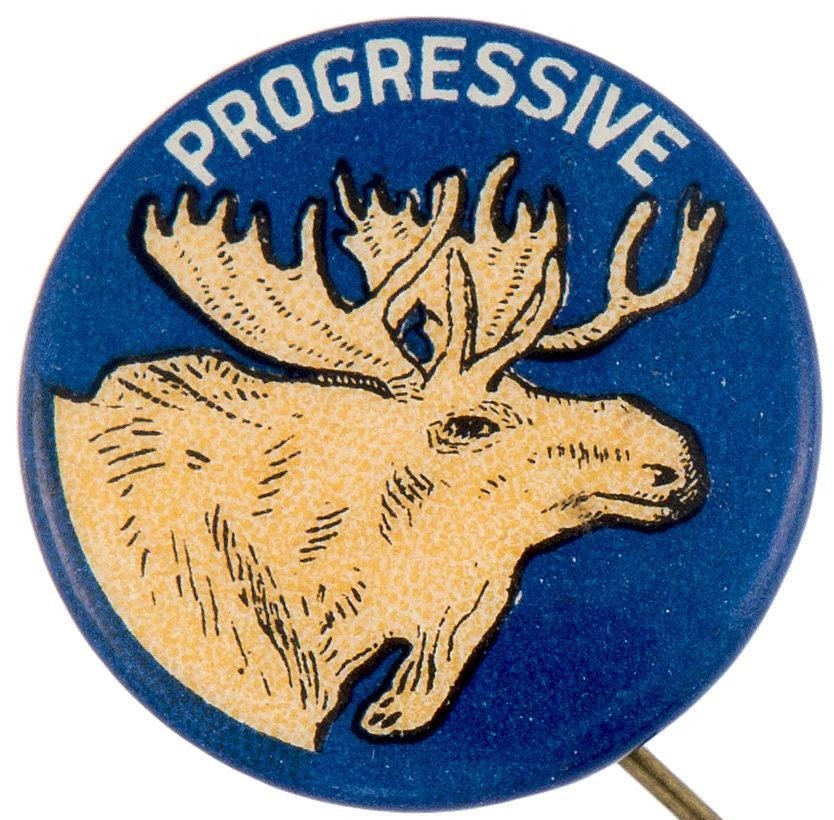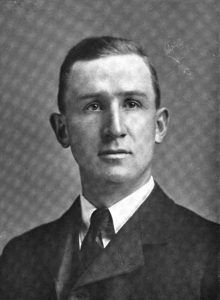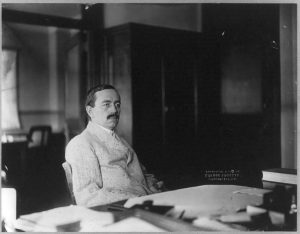By Nancy Finlay
Connecticut was a staunchly Republican state at the beginning of the 20th century. A solid majority voted for William McKinley in the presidential election of 1900, and in 1904, the state supported the re-election of Theodore Roosevelt (who succeeded to the presidency upon McKinley’s assassination in 1901). Roosevelt pledged not to run for a third term—his hand-picked successor, William Howard Taft, easily won in 1908, again with strong support from the Nutmeg State.
Taft proved more conservative in his policies than Roosevelt anticipated, however, producing a split in the Republican Party between those who supported the new president, and those who remained loyal to his predecessor. The results were evident as early as the mid-term election of 1910, when Democrats gained control of the House of Representatives for the first time since 1894 and drastically narrowed the Republicans’ margin in the Senate. Connecticut elected a Democratic governor for the first time in 16 years.
Then in 1912, Roosevelt challenged Taft for the Republican nomination. Although Roosevelt won overwhelmingly in the primaries, delegates to the Republican National Convention selected President Taft as their nominee. Undeterred, Roosevelt went on to run as a third-party candidate, representing the newly formed Progressive Party. The Progressive Party supported organized labor against big business, was in favor of women’s suffrage, and even proposed a national health service. Most of the party’s followers were former Republicans, but a few Democrats also joined— attracted by the party’s high-minded objectives. Supporters nicknamed the party the “Bull Moose Party” after Roosevelt proclaimed that he was “fit as a bull moose.”
Theodore Roosevelt in Connecticut
Roosevelt anticipated strong support in Connecticut, where he had many friends and where he was a frequent visitor at his sister’s home in Farmington. Herbert Knox Smith, another Farmington resident, resigned as United States Commissioner of Corporations to manage Roosevelt’s campaign in Connecticut. Roosevelt had appointed Smith and he had been part of Roosevelt’s “Tennis Cabinet”—an informal group of young men who shared the president’s enthusiasm for vigorous outdoor exercise.
Avon’s Joseph W. Alsop IV—a state senator married to Roosevelt’s niece, Corinne Douglas Robinson—was another Roosevelt supporter. Smith and Alsop campaigned tirelessly, organizing rallies throughout the state. On Labor Day, Roosevelt arrived by train at Hartford’s Union Station to deliver an address at the Connecticut State Fair in Charter Oak Park. He was greeted by huge crowds in Hartford as well as in Stamford, Bridgeport, New Haven, and Meriden, where his train stopped along the way.
Connecticut, however, is the Land of Steady Habits. Many voters did not approve of Roosevelt’s bid for a third term and continued to stay loyal to the Republican Party. The split in the party between loyal Republicans and Progressives meant that just as in 1910, the Democratic candidate—in this case Woodrow Wilson—was able to gain a majority of the votes. Taft ran a close second in Connecticut and Roosevelt came in third, with just half as many votes as the Republican candidate. Other Progressive ticket candidates like Smith, who ran for governor, and Alsop, who ran for US Representative, were also unsuccessful. Nationwide, Roosevelt did somewhat better, winning several states and coming in second, but Woodrow Wilson won a substantial margin in the popular vote, and an overwhelming victory in the Electoral College.
The End of the Bull Moose Party
The Election of 1912 marked the end of Roosevelt’s political career and also the careers of his Connecticut supporters—Smith and Alsop. Smith never held political office again. He served in World War I and was active as a lawyer and a judge until his death in 1931. Following Roosevelt’s death in 1919, Smith organized annual pilgrimages to the former president’s grave.
Alsop started an insurance company and continued to run his tobacco farm in Avon, where he served as first selectman from 1922 to 1950. He died in 1953.
After women gained the right to vote in 1920, both men’s wives became involved in politics. Smith’s wife Gertrude served for many years as the president of the Connecticut League of Women Voters. Corinne Robinson Alsop served in the Connecticut House of Representatives from 1925 to 1926 and from 1929 to 1931. She was a life-long Republican and in 1936 was a delegate to the Republican National Convention. She frequently visited the White House during these years, remaining close to her cousin Eleanor Roosevelt and Eleanor’s husband President Franklin Delano Roosevelt, despite their political differences.
Nancy Finlay grew up in Manchester, Connecticut. She has a BA from Smith College and an MFA and PhD from Princeton University. From 1998 to 2015, she was Curator of Graphics at the Connecticut Historical Society.












